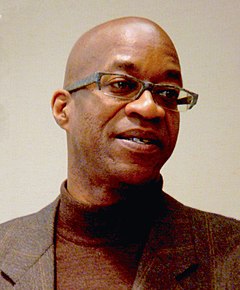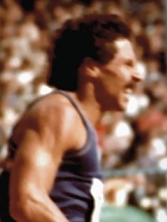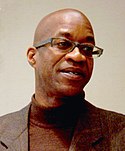Mistrzostwa Świata w Lekkoatletyce 1983 – bieg na 400 m przez płotki mężczyzn
Bieg na 400 metrów przez płotki mężczyzn – jedna z konkurencji biegowych rozgrywanych podczas lekkoatletycznych mistrzostw świata na Stadionie Olimpijskim w Helsinkach.
Terminarz
| Data | |
|---|---|
| 7 sierpnia | Eliminacje |
| 8 sierpnia | Półfinały |
| 9 sierpnia | Finał |
Rekordy
| Zawodnik | Wynik | Miejsce | Data | |
|---|---|---|---|---|
| Rekord świata | 47,13 | 3 lipca 1980(dts)[1] |
Wyniki
Eliminacje
Rozegrano pięć biegów eliminacyjne. Z każdego biegu dwóch najlepszych zawodników automatycznie awansowało do półfinałów (Q). Skład półfinalistów uzupełniło sześciu najszybszych płotkarzy spośród pozostałych (q).
Bieg 1
| Poz. | Imię i nazwisko | Reprezentacja | Wynik | Uwagi |
|---|---|---|---|---|
| 1 | André Phillips | 50,44 | Q | |
| 2 | Rik Tommelein | 50,99 | Q | |
| 3 | Gary Oakes | 51,23 | ||
| 4 | Ian Newhouse | 51,45 | ||
| 5 | Meshak Munyoro | 53,25 | ||
| 6 | Paiwa Bogela | 54,68 | ||
| – | Aleksandr Jacewicz | DNF |
Bieg 2
| Poz. | Imię i nazwisko | Reprezentacja | Wynik | Uwagi |
|---|---|---|---|---|
| 1 | Aleksandr Charłow | 50,12 | Q | |
| 2 | Sven Nylander | 50,23 | Q | |
| 3 | José Alonso | 50,53 | q | |
| 4 | Vladislav Pecen | 50,86 | ||
| 5 | István Takács | 50,97 | ||
| Peter Rwamuhanda | 50,99 |
Bieg 3
| Poz. | Imię i nazwisko | Reprezentacja | Wynik | Uwagi |
|---|---|---|---|---|
| 1 | David Lee | 50,15 | Q | |
| 2 | Toma Tomow | 50,39 | Q | |
| 3 | Karl Smith | 50,64 | q | |
| 4 | Thomas Futterknecht | 50,68 | ||
| 5 | Antônio Dias Ferreira | 50,76 | ||
| 6 | Stephen Sole | 51,90 | ||
| 7 | Ahmed Ghanem | 52,32 |
Bieg 4
| Poz. | Imię i nazwisko | Reprezentacja | Wynik | Uwagi |
|---|---|---|---|---|
| 1 | Edwin Moses | 49,54 | Q | |
| 2 | Daniel Ogidi | '50,44 | Q | |
| 3 | Amadou Dia Ba | 50,59 | q | |
| 4 | Krasimir Demirew | 50,62 | q | |
| 5 | Greg Rolle | 50,92 | ||
| 6 | Rok Kopitar | 52,34 | ||
| – | Carlos Azulay | DQ |
Bieg 5
| Poz. | Imię i nazwisko | Reprezentacja | Wynik | Uwagi |
|---|---|---|---|---|
| 1 | Harald Schmid | 49,99 | Q | |
| 2 | Ryszard Szparak | 50,09 | Q | |
| 3 | Franz Meier | 50,09 | q | |
| 4 | Ahmed Hamada | 50,63 | q | |
| 5 | Petter Hesselberg | 51,67 | ||
| 6 | Jeorjos Wamwakas | 51,92 | ||
| 7 | David Charlton | 52,02 |
Półfinały
Rozegrano dwa biegi półfinałowe. Z każdego biegu czterech najlepszych zawodników awansowało do finału (Q).
Bieg 1
| Poz. | Imię i nazwisko | Reprezentacja | Wynik | Uwagi |
|---|---|---|---|---|
| 1 | Edwin Moses | 48,11 | Q | |
| 2 | André Phillips | 48,99 | Q | |
| 3 | Amadou Dia Ba | 49,18 | Q | |
| 4 | Aleksandr Charłow | 49,75 | Q | |
| 5 | Ahmed Hamada | 50,04 | ||
| 6 | Franz Meier | 50,31 | ||
| 7 | Rik Tommelein | 50,54 | ||
| – | Toma Tomow | DNS |
Bieg 2
| Poz. | Imię i nazwisko | Reprezentacja | Wynik | Uwagi |
|---|---|---|---|---|
| 1 | Harald Schmid | 48,57 | Q | |
| 2 | David Lee | 48,63 | Q | |
| 3 | Ryszard Szparak | 49,17 | Q, | |
| 4 | Sven Nylander | 49,18 | Q | |
| 5 | Daniel Ogidi | '49,51 | ||
| 6 | José Alonso | 49,91 | ||
| 7 | Karl Smith | 49,99 | ||
| 8 | Krasimir Demirew | 50,91 |
Finał
| Poz. | Imię i nazwisko | Reprezentacja | Wynik |
|---|---|---|---|
| 1 | Edwin Moses | 47,50 | |
| 2 | Harald Schmid | 48,61 | |
| 3 | Aleksandr Charłow | 49,03 | |
| 4 | Sven Nylander | 49,06 | |
| 5 | André Phillips | 49,24 | |
| 6 | David Lee | 49,32 | |
| 7 | Amadou Dia Ba | 49,61 | |
| 8 | Ryszard Szparak | 49,78 |
Przypisy
- ↑ Progression of IAAF World Records. 2015 Edition, IAAF, s. 130–131 [dostęp 2021-08-07] (ang.).
- ↑ Janusz Waśko, John Brant, Györgyi Csiki, Andrzej Socha: Golden Century of IAAF Records. National Records Evolution 1912-2012. Zamość: 2013, s. 87. ISBN 978-83-62033-30-0. (ang.).
Bibliografia
- IAAF World Athletics Championships Doha 2019 Statistics Handbook, World Athletics, s. 152–153 [dostęp 2021-08-07] (ang.).
Media użyte na tej stronie
An icon that represents a gold medal
The flag of Navassa Island is simply the United States flag. It does not have a "local" flag or "unofficial" flag; it is an uninhabited island. The version with a profile view was based on Flags of the World and as a fictional design has no status warranting a place on any Wiki. It was made up by a random person with no connection to the island, it has never flown on the island, and it has never received any sort of recognition or validation by any authority. The person quoted on that page has no authority to bestow a flag, "unofficial" or otherwise, on the island.
An icon that represents a silver medal
An icon that represents a bronze medal
Autor: Pedro A. Gracia Fajardo, escudo de Manual de Imagen Institucional de la Administración General del Estado, Licencja: CC0
Flaga Hiszpanii
Autor: Scroch, Licencja: CC BY-SA 3.0
Flag of Bulgaria (1971-1990). Flag of Bulgaria with Bulgarian coat from 1971.
Flag of Jamaica. “The sunshine, the land is green, and the people are strong and bold” is the symbolism of the colours of the flag. GOLD represents the natural wealth and beauty of sunlight; GREEN represents hope and agricultural resources; BLACK represents the strength and creativity of the people. The original symbolism, however, was "Hardships there are, but the land is green, and the sun shineth", where BLACK represented the hardships being faced.
Flag of Senegal
Flag of the Socialist Federal Republic of Yugoslavia (1946-1992).
The design (blazon) is defined in Article 4 of the Constitution for the Republic of Yugoslavia (1946). [1]
Flag of the Socialist Federal Republic of Yugoslavia (1946-1992).
The design (blazon) is defined in Article 4 of the Constitution for the Republic of Yugoslavia (1946). [1]
Sport records icon to be used for national records.
Flaga Finlandii
Pictograms of Olympic sports – . This is an unofficial sample picture. Images of official Olympic pictograms for 1948 Summer Olympics and all Summer Olympics since 1964 can be found in corresponding Official Reports.
Autor: Fotografia: Diane Krauss / DianeAnna, Licencja: CC-BY-SA-3.0
Harald Schmid beim Internationalen Leichtathletik-Sportfest in Köln, 1981
The Egyptian flag (1972-1984). Also the flag of Libya (1972-1977) and Syria (1972-1980), when the three countries formed the nominal “Federation of Arab Republics”. (For a map of the federation, see Image:Esl.PNG.)
The Arab text in the scroll held by the “Golden Hawk of Qureish” reads Arabic اتحاد الجمهوريات العربية, ittiħād al-jumhūriyyāt al-`arabiyya, i.e. the Federation (literally “Union”) of Arab Republics — in a quasi-Kufic script (in its original form, with a very ornamental letter dal د).
Autor: Andy Miah from Liverpool, UK, Licencja: CC BY-SA 2.0
Edwin Moses

































